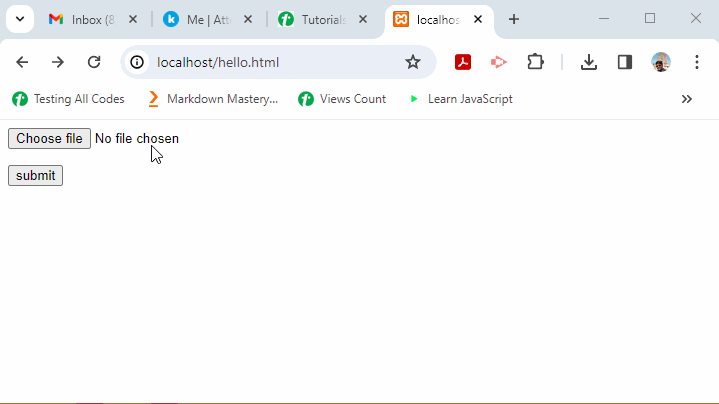$_FILES is one of the ‘superglobal’, or automatic global, variables in PHP. It is available in all scopes throughout a script. The variable $_FILES is an associative array containing items uploaded via HTTP POST method.
A file is uploaded when a HTML form contains an input element with a file type, its enctype attribute set to multipart/form-data, and the method attribute set to HTTP POST method.
$HTTP_POST_FILES also contains the same information, but it is not a superglobal, and it has now been deprecated.
The following HTML script contains a form with input element of file type −
<input type="file" name="file">This “input type” renders a button captioned as file. When clicked, a file dialogbox pops up. You can choose a file to be uploaded.
The PHP script on the server can access the file data in $_FILES variable.
The $_FILES array contains the following properties −
- $_FILES[‘file’][‘name’] − The original name of the file that the user has chosen to be uploaded.
- $_FILES[‘file’][‘type’] − The mime type of the file. An example would be “image/gif”. This mime type is however not checked on the PHP side.
- $_FILES[‘file’][‘size’] − The size, in bytes, of the uploaded file.
- $_FILES[‘file’][‘tmp_name’] − The temporary filename of the file in which the uploaded file was stored on the server.
- $_FILES[‘file’][‘full_path’] − The full path as submitted by the browser. Available as of PHP 8.1.0.
- $_FILES[‘file’][‘error’] − The error code associated with this file upload.
The error codes are enumerated as below −
| Error Codes | Description |
|---|---|
| UPLOAD_ERR_OK (Value=0) | There is no error, the file uploaded with success. |
| UPLOAD_ERR_INI_SIZE (Value=1) | The uploaded file exceeds the upload_max_filesize directive in php.ini. |
| UPLOAD_ERR_FORM_SIZE (Value=2) | The uploaded file exceeds the MAX_FILE_SIZE. |
| UPLOAD_ERR_PARTIAL (Value=3) | The uploaded file was only partially uploaded. |
| UPLOAD_ERR_NO_FILE (Value=4) | No file was uploaded. |
| UPLOAD_ERR_NO_TMP_DIR (Value=6) | Missing a temporary folder. |
| UPLOAD_ERR_CANT_WRITE (Value=7) | Failed to write file to disk. |
| UPLOAD_ERR_EXTENSION (Value=8) | A PHP extension stopped the file upload. |
Example
The following “test.html” contains a HTML form whose enctype is set to multiform/form-data. It also has an input file element which presents a button on the form for the user to select file to be uploaded. Save this file in the document root folder of your Apache server.
<html><body><form action="hello.php" method="POST" enctype="multipart/form-data"><p><input type="file" name="file"></p><p><input type ="submit" value="submit"></p></form></body></html>The above HTML renders a button named “Choose File” in the browser window. To open a file dialog box, click the “Choose File” button. As the name of selected file appears, click the submit button.

Example
The server-side PHP script (upload.php) in the document root folder reads the variables $_FILES array as follows −
<?php
echo "Filename: " . $_FILES['file']['name']."<br>";
echo "Type : " . $_FILES['file']['type'] ."<br>";
echo "Size : " . $_FILES['file']['size'] ."<br>";
echo "Temp name: " . $_FILES['file']['tmp_name'] ."<br>";
echo "Error : " . $_FILES['file']['error'] . "<br>";
?>It will produce the following output −
Filename: abc.txt
Type : text/plain
Size : 556762
Temp name: C:\xampp\tmp\phpD833.tmp
Error : 0
Example
In PHP, you can upload multiple files using the HTML array feature −
<html><body><form action="hello.php" method="POST" enctype="multipart/form-data"><input type="file" name="files[]"/><input type="file" name="files[]"/><input type ="submit" value="submit"/></form></body></html>Now, change the PHP script (hello.php) to −
<?php
foreach ($_FILES["files"]["name"] as $key => $val) {
echo "File uploaded: $val <br>";
}
?>
Leave a Reply